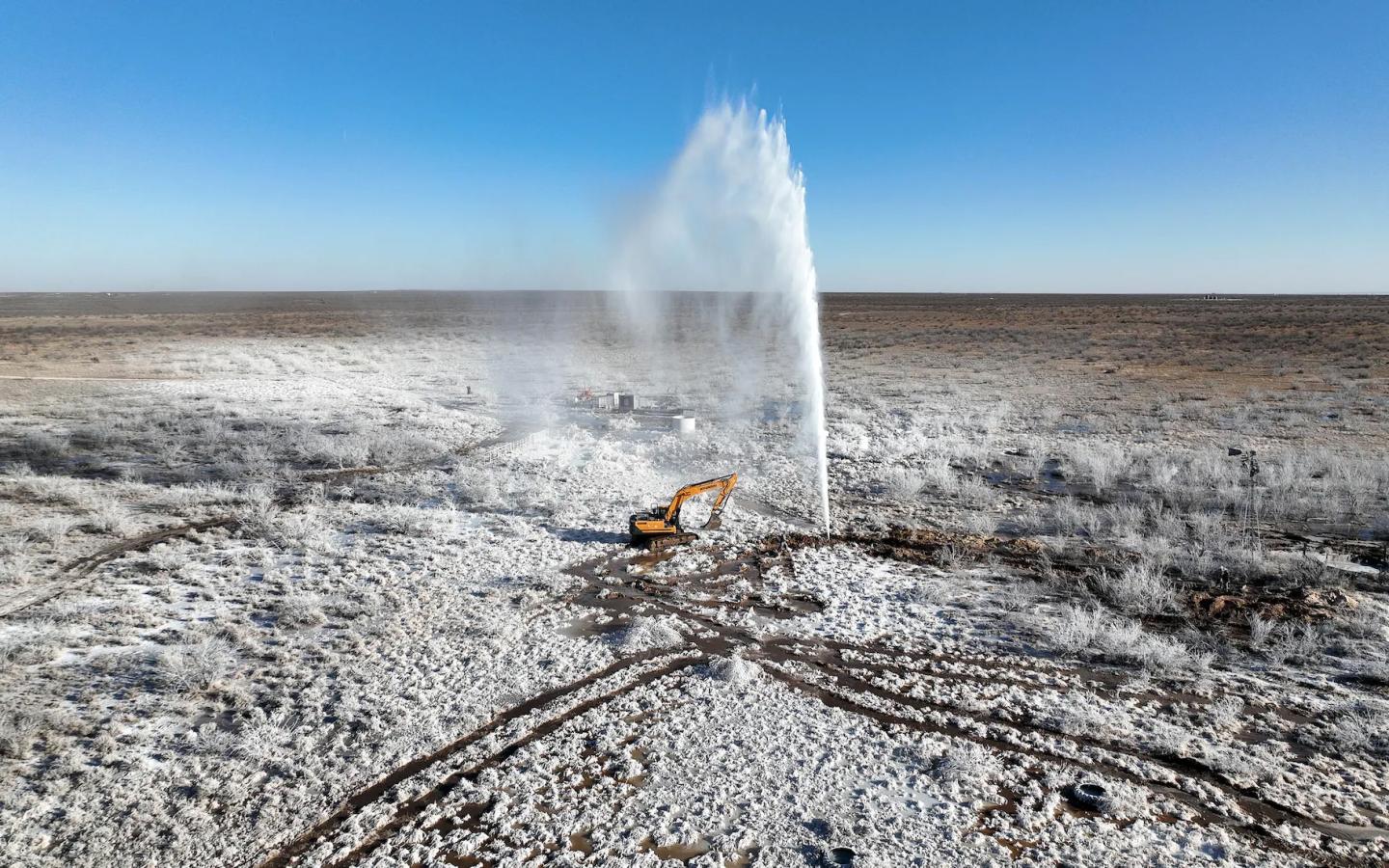The US needs to capture a billion tons of carbon a year. How we do it matters
The landscape of Crane County in west Texas doesn’t have a lot of distinguishing features. It’s mostly miles of scrubland as far as the eye can see. But in the early hours of Jan. 1, 2022, that flat monotony was shattered when a 100-foot geyser of salty water erupted from the ground. It spewed hundreds of thousands of barrels of brine into the air, painting the landscape white with salt.

Ten days later, the culprit was found: an old, dry oil well plugged in 1957 by the now-defunct Gulf Oil. Chevron, which acquired Gulf Oil in the 1980s, took responsibility for the blowout and the cleanup.
Holding owners and operators responsible for problems with improperly managed wells for an indefinite period — even decades after work on a site has ceased — is established procedure in oilfields across the country.
But this norm might be about to change. If drilling companies get their way, taxpayers could be on the hook instead.
Ironically, the technology that’s driving this change is meant to be good for the climate.
The new game in town: carbon sequestration
Carbon capture and sequestration, or CCS, is the process of capturing carbon dioxide released from industrial sources, like power plants and steel factories, and storing it in perpetuity by injecting it deep underground. It is sometimes also considered to include CO2 that is captured directly from the air.
The technology has existed for decades but has never been used at scale. In recent months, however, the EPA has been deluged with more than 70 permitting requests for new carbon dioxide injection wells, from both established oil and gas companies and new specialists.
Why the sudden interest in a technology that has been around for decades? In a word — climate.
In order to avoid catastrophic climate consequences, the U.S. is working to produce no more carbon pollution than it can remove from the atmosphere — a strategy called net-zero. And researchers estimate that even with recent progress on slashing climate pollution, the U.S. would still need to trap about 1 billion tons of carbon every year to reach net zero by 2050. Many climate modelers have calculated that CCS will be an important tool in reaching that net zero goal.
However, CCS faces challenges in delivering on its potential, including unresolved concerns from impacted communities that CCS will allow polluting facilities to continue operating and worsen local air quality. Another challenge is scale. There are only two operating carbon dioxide injection wells in the country, both at the Archer Daniels Midland biofuel plant in Decatur, Illinois. Together, they only capture around 1.3 million tons of carbon per year — barely a sliver of the storage needed.
Some states have loosened liability requirements
Scaling up CCS to the gigaton level didn’t seem feasible until recently. The passage of the Bipartisan Infrastructure Law of 2021 and the Inflation Reduction Act of 2022 made historic federal investments in climate technologies, including a major tax credit increase for CCS.
Now, as would-be CCS companies look to set up shop, states across the country are scrambling to make the case that they are the best place to do business.
Ten states have passed statutes that, to varying degrees, relieve carbon sequestration well operators of long-term liability over an injection site. That means the state would be on the hook for any maintenance or cleanup after the well has formally been closed.
This is a trend that Adam Peltz, an energy attorney for Environmental Defense Fund, finds alarming, and is working to reverse.
“On the one hand, you have industry assuring the public that it is perfectly safe to inject millions of tons of carbon dioxide deep underground, while on the other hand demanding to be released from any responsibility down the line if things go wrong,” said Peltz. “This erodes public trust in, and support of, the technology. And it disincentivizes companies from taking all possible precautions.”

In many of the states with liability releases, well operators would be required to pay into a fund while the well is active, for future care of the site. But these funds are only designed to cover basic monitoring and maintenance of closed wells. They wouldn’t be able to cover the cost of any serious problems or major disasters. Plus, these sorts of funds have a history of being raided to balance state budgets.
“We don't have to imagine what might go wrong if companies aren't operating with the expectation of being responsible for decades to come,” said Peltz. “One hundred and seventy years of oil and gas development has already left us with a massive inventory of old, unplugged wells with no solvent owner on the books. These orphan wells are leaking methane, air toxics and contaminating groundwater across the country.”
- Finally, a plan — and money — to clean up pollution from abandoned oil and gas wells.
- Four ways carbon capture can reverse climate pollution
Without enough money in state coffers to cover the cost of clean up, the pollution from abandoned wells can simply go unaddressed — a fate that must be avoided with carbon sequestration wells.
Setting guardrails on carbon storage
Many, including the Intergovernmental Panel on Climate Change, consider the underlying technology for sequestering CO2 in geologic formations to be safe and effective when done correctly, but it is not without risks.
Poorly managed projects could increase the risk of carbon dioxide leaking through natural fissures or old wells. If CO2 contaminates groundwater or escapes into the atmosphere, that would defeat the entire purpose of an enterprise that is supposed to protect the climate.
Moreover, CCS projects have sparked numerous other concerns from disproportionately impacted communities, especially the threat of perpetuating the fossil fuel industry, the risk of public health impacts from industrial facilities where CO2 capture would take place, and the potential dangers of transport of CO2 (a heavier-than-air asphyxiant) in underregulated pipelines.
“If CCS is going to be done safely, companies must retain a level of responsibility and accountability,” said Peltz. “But shifting the burden of risk to the public gives companies an out.”
Peltz and EDF are leaders in a broad coalition of local and national groups working to put the brakes on CCS liability releases, among other potential hazards from this nascent industry. They successfully helped defeat two such bills in Texas. A similar bill in Colorado never made it to the floor.
In Pennsylvania, legislation with EDF-inspired safeguards that revert liability to operators in case of wrong-doing was introduced this summer. And in Illinois, EDF is working to improve liability release legislation expected this fall.
Louisiana became the first state in the country to limit CCS liability exemptions adopted previously, although the improvements did not go as far as needed. Both the state’s liability regime and other problems have caused EDF to say that Louisiana is not ready to regulate CCS at this time.
EDF is also making the case to the EPA that it should deny states the authority to regulate their own carbon dioxide injection wells if they adopt overly broad liability release statutes, and that the Department of Energy should not fund CCS projects in such states.
“This is a powerful lever because states desperately want to streamline the permitting process and avoid potential bottlenecks at the EPA,” said Peltz.
For states to be granted the right to regulate these wells they must prove to the EPA that, at a minimum, they will hold well operators to a standard as high or higher as federal regulators. And letting operators wriggle out of long-term liability doesn’t meet that standard, according to Peltz.
“CCS must be a long-term climate solution. Companies that want to be part of that solution need to be in it for the long-term too,” said Peltz.
“A whole new industry worth trillions of dollars is about to take off. For the sake of the climate we need to move fast, but not at the expense of doing it right.”


